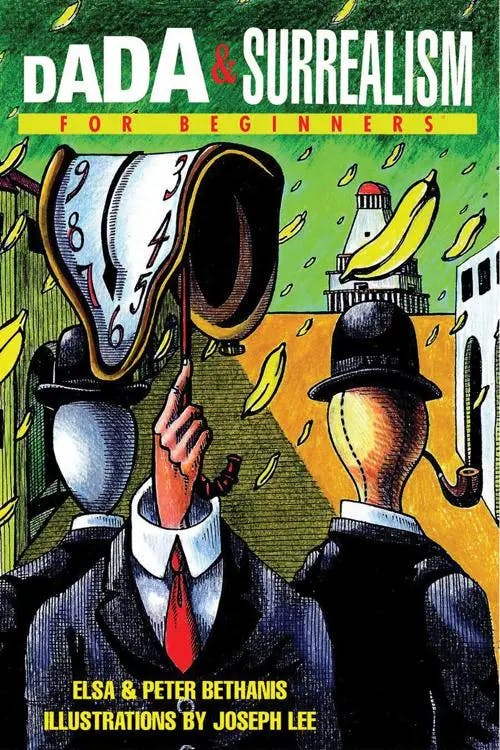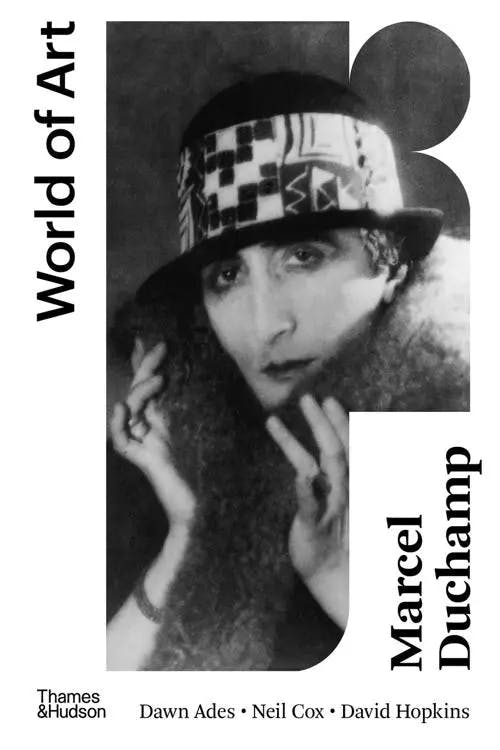What is Dadaism? Understanding the Dada Art Movement
PhD, Media Arts (Royal Holloway, University of London)
Date Published: 06.03.2023,
Last Updated: 05.10.2023
Share this article
Defining the Dada Movement
Dada was an art movement that began around 1915, falling under the umbrella of what Peter Bürger describes as the ‘historical avant-garde’ (1984, 53). Though it is difficult to determine exactly where Dada was first developed, with Dadaist activity taking place simultaneously in a number of different parts of the world, the most significant early Dadaist hubs were New York and Zurich. The movement is said to have been formally founded at the Cabaret Voltaire in neutral Switzerland in 1916.
That year, Hugo Ball wrote the first Dada Manifesto, a text only a few paragraphs in length. In it, Ball explains the meaning of the emerging movement’s title,
Dada comes from the dictionary. It is terribly simple. In French it means "hobby horse." In German it means "good-by," "Get off my back," "Be seeing you sometime." In Romanian: "Yes, indeed, you are right, that's it. But of course, yes, definitely, right." And so forth. An international word. Just a word, and the word a movement. Very easy to understand. Quite terribly simple. (1996)
In 1918, Tristan Tzara wrote a longer, more comprehensive Dada manifesto that claimed that ‘Dada Means Nothing’ (2001). So, if ‘Dada’ is a near-nonsensical word, how can we identify the purpose of the movement it delineates?
In a sense, the clue is in the arbitrary assignment of its nonsense name: Dada was concerned with the irrational, the illogical, the structureless, the meaningless, the absurd. A response to the horrors of the First World War and the rise of violence, nationalism, and capitalism, Dada is often described as an ‘anti-art’ movement. It rejected art as an institution. For the Dadaists art should not be caught in the trappings of bourgeois aestheticism, of capital value or political propaganda, but rather transcend these structures and expectations to reveal the chaos of the world. This radical project was carried out through strange and disorienting performances, abstract poetry and drawings, loud music, and disjointed films and collages that challenged the concept, reach, and limitations of art.
However, even though much of these works can be studied in the wealth of Dada publications, the Dadaists were not particularly concerned with the longevity of their work or enthusiastic about the documentation of their activity.
Elsa and Peter Bethanis explain this in Dada and Surrealism for Beginners, where they assert,
to their way of thinking, work that’s documented becomes too stale and too easily claimed by the bourgeois, where it not only becomes acceptable but also loses its spontaneity and vibrancy – qualities that made it Dada in the first place (2007)
Elsa Bethanis, Peter Bethanis, Joe Lee
to their way of thinking, work that’s documented becomes too stale and too easily claimed by the bourgeois, where it not only becomes acceptable but also loses its spontaneity and vibrancy – qualities that made it Dada in the first place (2007)
Alongside cubism, futurism, and expressionism, Dada was a pioneering moment in the European avant-garde and is often heralded as the precursor to Surrealism. Described by Emily Hage in Dada Magazines as ‘heterogeneous, transnational, nonhierarchical, multilingual, and radically contingent’, Dada embodied a resistance to the institutions and structures that threatened art, freedom, and subjectivity (2020).
Dada and nihilisms
Echoing the assertions of Tzara, Dadaist Francis Picabia claimed in his 1920 manifesto that ‘the Dadaists are nothing, nothing, nothing-certainly they will come to nothing, nothing, nothing’ (2001). By now we can identify an association between Dada and absence or negation; this concept of ‘nothingness.’ Hence, a natural philosophical ally to Dada was nihilism. Nihilism is a philosophical position that supposes that there is no inherent structure or order in the world; it maintains a skepticism as to the certainty of existence. Perhaps most pertinent to Dada was the nihilism of German philosopher Friedrich Nietzsche with prominent Dadaists Picabia and Marcel Duchamp assimilating his philosophy into their own artistic practice. Nietzschean nihilism is primarily understood through the crisis of self that occurs when we apprehend the meaninglessness of the world. In A Defence of Nihilism, James Tartaglia and Tracy Llanera explain how this crisis arises, claiming ‘centuries of religious indoctrination had led people to invest all value and significance in an imaginary meaning of life’ (2020). This metaphysical stability was confronted in modernity by the horrors of war and the reign of materialist thought and logical reasoning. Once this sense of purpose was met with scrutiny and skepticism, a crisis of meaning, truth, and morals ensued. Nihilism was one possible response to such a crisis, one that Dada, in its efforts to reveal the meaninglessness of the world and negate the structures of modernity, was particularly drawn to.
The socio-political context that Dada responded to was one that threatened the autonomy of the individual. With the rise of industrialization and the subsequent mechanization of the body, the modern subject was at risk. Nihilism offered Dada a means of rejecting the imposed function of the subject in order to reaffirm the subject as the only locus of control and order in the world. Nihilism and Dada alike saw the world as inherently chaotic and meaningless. Hence, they emphasized the power of the subject in generating meaning and imposing structure. For the Dadaists, negation paradoxically was a means of creation.
Nihilism offered Dadaists a framework to simultaneously debunk the political, social, and cultural forces of wartime Europe as well as contend with the complicated philosophical relationship between the artist and the artwork, the self, and the world.
Dadaist art
Many Dadaist works have gone down in history for the way they challenged the limits of the art world. Marcel Duchamp’s 1917 sculpture, Fountain, is one such emblematic piece of modern art. Fountain is a porcelain urinal displayed on its back. There is little that would distinguish it from what might be found in a men’s bathroom other than its presence in a gallery and the pseudonym, ‘R. Mutt’, signed on it along with the date ‘1917’. Fountain is an example of what Duchamp referred to as a ‘readymade’.
In Marcel Duchamp (2021), Dawn Ades and Neil Cox describe readymades as,
mass-produced objects that have been signed and sometimes inscribed by the artist...Duchamp himself usually insisted in interviews on the vague and almost accidental way in which each one came into existence. (2021)
Dawn Ades, Neil Cox
mass-produced objects that have been signed and sometimes inscribed by the artist...Duchamp himself usually insisted in interviews on the vague and almost accidental way in which each one came into existence. (2021)
By replacing a revered classical artform like a sculpture with a common and vulgar object like a urinal, Dada mocked the seriousness of art. As objects that are found rather than created, readymades invite chance and coincidence into the artworld, challenging the intentionality of art and the autonomy of the artist. With the artist positioned as a mere conduit of chance, the artist can exist without formal training or any aesthetic ability or superiority whatsoever. This relationship between the artwork and the artist was further complicated by the signing of a pseudonym, a regular feature of Dadaist works, once more poking fun at artistic authorship and the commodification of the artist’s name and signature. This was all in the spirit of loosening the grip of bourgeoisie on the art world and subverting the cultural conventions that dictated artistic success. What Duchamp most significantly achieved with Fountain was a discourse surrounding the questions: What is art? Why is one thing art and not another? What makes an artist?
While Duchamp expressed the meaningless of the world through readymades, another artist was more inclined towards collage. Hannah Höch is a German artist associated with Dada. Her famous use of collage captured the sense of fragmentation, destruction, and senseless chaos that followed World War I. In A Companion to Dada and Surrealism, Adam Joles claims Höch’s collages ‘form an ensemble of loosely allegorical images critical of virtually every institution upon which modern Germany had been founded’ (2016). In particular, these photomontages explore the female subject, challenging the perceived reconstruction of ‘womanhood’ that was taking place in the interwar years. In her 1919 work, Cut with the Kitchen Knife Dada through the Last Weimar Beer-Belly Cultural Epoch in Germany, Höch’s own means of signing her work was to stick a tiny photo of her face in the collaged chaos next to a map of Europe that demarcated where women had the right to vote. Elsewhere in the collage, German emperor Wilhelm II’s face appears, with two upside-down wrestlers constituting his moustache, under the cut-out words ‘anti-dada’. This piece exemplifies the way that messages of political radicalism and critiques of structure and authority emerge in the deconstruction, chaos, and humor of Dada.
The legacy of Dada
It seems that Dada as an organized movement was more or less dissolved by the development of its successor, Surrealism. Although Dada and Surrealism are often linked, it is important to consider their differences. Where Dada reveled in the nihilistic meaninglessness of the world, Surrealism looked to the Freudian unconscious and Marxism to reimagine a world through more typical artistic materials. Dada was fundamentally opposed to authority, which was reflected in the organization of their movement. Surrealism, on the other hand, was significantly more contained, guided by the firm leadership of André Breton. Hence, Surrealism took the irrational and absurd character of Dada and distilled it into a more comprehensible set of artistic techniques and principles.
Indeed, Dada has not garnered the contemporary layman’s use and common understanding that Surrealism has. Nonetheless, Dada is recognized as a pivotal moment in art history which changed the trajectory of art and laid the foundations of much of the modern art that followed. Famous figures of what Bürger calls the ‘neo-avant-garde’, developed in the 1950s, 60s and 70s, were evidently inspired by the pioneering work of the Dadaists (1984, 53). The Pop-Art of Andy Warhol provides an example of artwork that builds on the concept of the every-day object in a formal artistic setting.
Elsa and Peter Bethanis explain this development, writing,
In the tradition of the ready-made, Warhol does not displace the notion of the object in the gallery but strives to implant it in one’s memory through repetition and easily recognized icons. Warhol’s pop art transforms the idea of ready-mades into tangible objects we have encountered thousands of times while at the same time placing us in a state of odd limbo as we gaze at soup cans in an unfamiliar context (like a museum). (2007)
Like Dada, Warhol’s work is a commentary on the commodification of art, blurring the lines between art and the simultaneous absurdity and mundanity of everyday.
Music genres like punk and rock have been connected to the project of Dada as well as some comic books and graffiti. Dada represents an attack on its own medium, replacing artistic standards with imperfection, resulting in a loud and confrontational aesthetic that reverberates in much music and art today. With the spirit of anarchy and disillusionment with convention and authority, genres like punk and graffiti seek to challenge the status quo and shake cultural activity from a standard of acceptability. Though not a household label, traces of Dada can be found wherever ‘low brow’ aesthetics meet expressions of rebellion (2007).
Further Dada reading & resources on Perlego
Dada bodies: Between Battlefield and Fairground by Elza Adamowicz
The Posthuman Dada Guide: Tzara and Lenin Play Chess by Andrei Codrescu
Nihilism and Technology by Nolen Gertz
The Problem of Affective Nihilism in Nietzsche by Kaitlyn Creasy
Duchamp, Aesthetics and Capitalism by Julian Jason Haladyn
Mama Dada: Gertrude Stein's Avant-Garde Theatre by Sarah Bay-Cheng
The Poetics of Noise from Dada to Punk by John Melillo
Bibliography
Adam J. (2016) A Companion to Dada and Surrealism. 1st ed. Wiley.
Ades, D., Cox, N. (2021) Marcel Duchamp. Thames and Hudson Ltd.
Ball, H. (1996) ‘Dada manifesto.’ Flight out of Time: A Dada Diary.
Bethanis, E., Bethanis, P., Lee, J. (2007) Dada and Surrealism for Beginners.
Bürger, P. (1984) Theory of the Avant-garde. Vol. 4. Manchester University Press.
Hage, E. (2020) Dada Magazines. 1st ed. Bloomsbury Publishing.
Tartaglia, J., Llanera, T. (2020) A Defence of Nihilism. 1st ed. Taylor and Francis.
Tzara, T. (2001) ‘Dadaist Manifesto.’ Trans. Mary Ann Caws. Manifesto: A Century of Isms. Ed. Mary Ann Caws. Lincoln: U of Nebraska.
PhD, Media Arts (Royal Holloway, University of London)
Aoiffe Walsh has a PhD in Media Arts from Royal Holloway, University of London. With a background in film studies and philosophy, her current research explores British literary modernism, with a particular focus on surrealism between the wars. She has lectured and published pieces on documentary and film theory, film history, genre studies and the avant-garde.


